Suzuki released its first new sportsbike in a long time this year. We spent a couple of weeks with the new 2024 GSX-8R to see what it’s like…
Sportsbikes have had a tricky time in recent years. Before about 2010, UK riders couldn’t get enough of the things. Japanese factories built them in the hundreds of thousands, imported them by the truck-load, and updated them every 18 months whether they needed to or not.
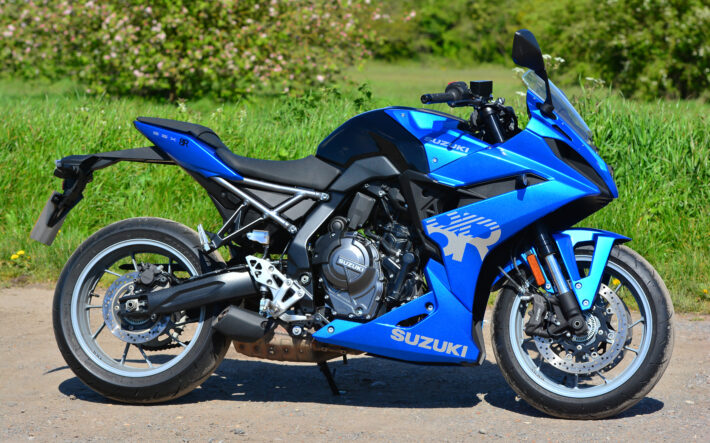
There were plenty of exotic European offerings as well, and just about anything with a massively powerful engine, full fairing, crippling riding position and license-frying performance got a giant thumbs up in the market. Trebles all round for the race-replica engineers!
Times change though, and a load of factors seemed to spell the end for high-performance supersports machines. The market got older, which meant a decline in youthful exuberance and an increase in stiff backs and knees. The spread of speed cameras and dash cams, together with stiffer penalties for speeding, made near-200mph speeds even less relevant that they were in the 1990s.

And the culture of motorcycling also went through a big change, with a growth in the desire for ‘adventure’, in whatever form rather than just speed. That adventure could involve riding to Mongolia, or it could simply mean riding a bike that looked like it could ride to Mongolia.
What it didn’t mean was a 200bhp superbike with no luggage and more electronic rider aids than a MotoGP bike.
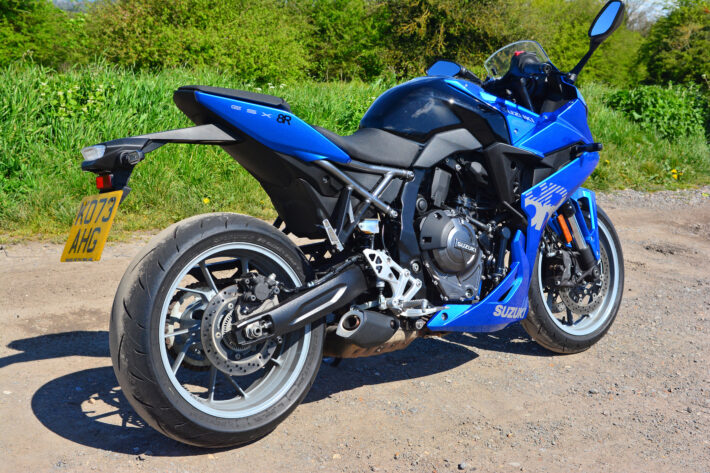
We know the rest. BMW’s R1200/1250/1300 GS and GS Adventure has been the top-selling bike for much of the past two decades, followed by facsimile machines from all the other big firms.
Adventure tourers are now the flagship products for their makers, with the best tech, most equipment, and increasingly superlative dynamic performance. We might want to be comfy and carry a load of luggage but the delights of a 180bhp engine still remain potent.
As we said earlier though – times change. And there are signs of a bit of a revival of the sportsbike market. Honda has brought back its CBR600RR, and Kawasaki has launched a new ZX-4RR for 2024.
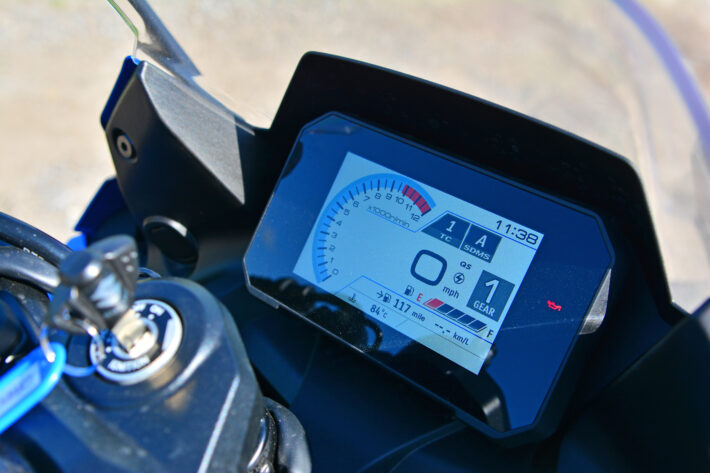
It’s the less-fancy sector which is arguably the most lively though: the middleweight road-sports class of 500-900 twins, triples and fours that has a dual appeal to novice riders stuck with an A2 restricted licence, and experienced riders looking for something less serious than a Fireblade, but still fun.
Kawasaki’s Ninja 650, Honda’s CBR650R, Triumph’s Daytona 660, Yamaha’s R7, the Aprilia RS660 – all different bikes, but with that same appeal, and focus on softer road-biased sporting prowess (the full-bore litre-class superbikes are now the last bastions of unlimited track focus). And now Suzuki’s joined in, with the new GSX-8R.
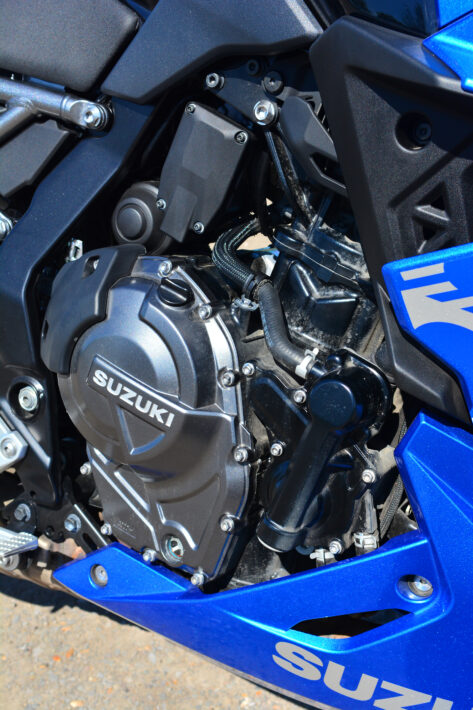
From the outside, Suzuki really needed this. Even before COVID gave everything a jolt, the firm had a fairly old, tired line-up of bikes. The GSX-R range which filled up both UK-bound container ships and Suzuki’s bank account in the 1990s and 2000s were on the wane: the 600 and 750 were finished by low sales and tighter Euro emissions regs.
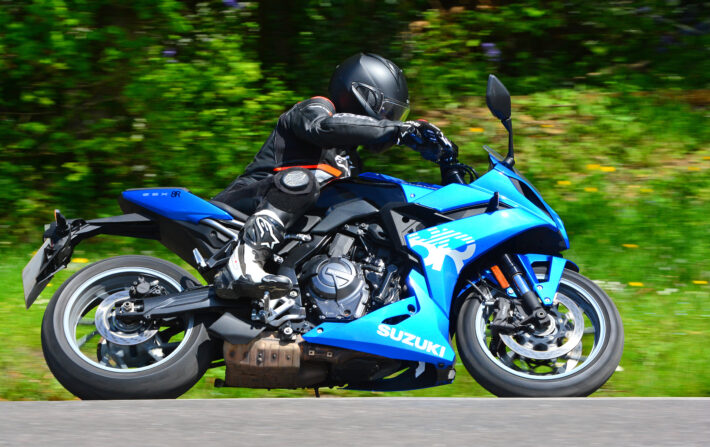
And while the GSX-R1000 got an update in 2017 that kept it going, it was far behind the best in the class. The company still had the Hayabusa, the 650 V-twin SV and DL models, and the basic GSX-S1000 naked models.
But they were also all fairly old models, on borrowed time, and as the pandemic tightened, it looked like the firm was about to run out of road.
Luckily, the Hamamatsu engineers were on the case, and had an all-new engine in the wings – the 776cc parallel twin unit which we first saw last year on the new V-Strom 800 and GSX-8S.
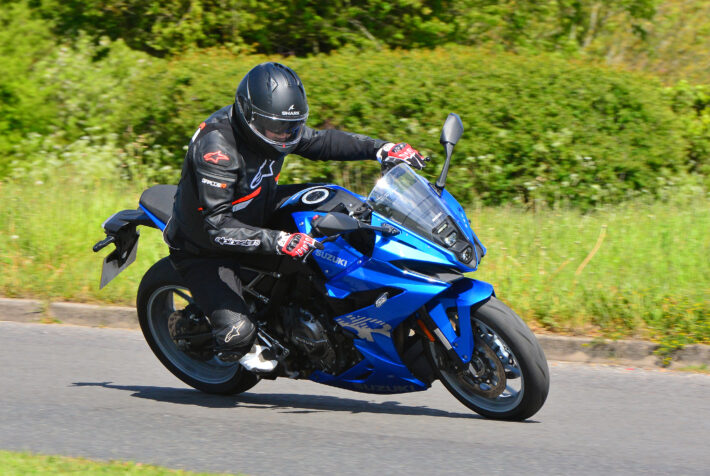
It’s a very modern design – though it’s a bit messy on the outside, with the water pump and thermostat area in particular looking as if it was just tacked on last-minute. It was a hit when launched, with both the V-Strom and GSX-8S doing well in press tests and punters praising the flexible, character-laden motor.
I picked the 8R up from Suzuki GB headquarters in Milton Keynes towards the end of the very miserable spring. I’d woken up to cold, grey, drizzly morning, and actually wore my KEIS electrically heated under jacket, with full winter riding gear for the pickup, swapping a GSX-S1000 GX for the little sportsbike.
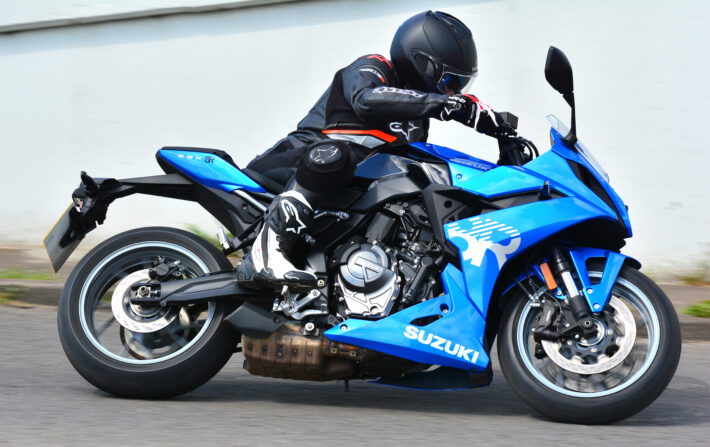
Of course, it was a bit of a contrast, jumping from the GSX-R-powered 1,000cc adventure tourer onto the compact sportster. But the fun levels stayed high, despite losing nearly half the horsepower (down to 81bhp from 152bhp).
As anyone who’s been near Milton Keynes knows, the place is riddled with roundabouts. So the first few miles were spent getting to know the 8R, all while dodging the various vans, cars and HGVs trundling around variously-themed circular junctions.
I soon escape the semi-urban hellscape though, and am out on some neat country roads towards Buckinghamshire. The first impressions of the GSX-8R are of quite a compact bike, with a low screen and minimal fairing coverage in front of you.
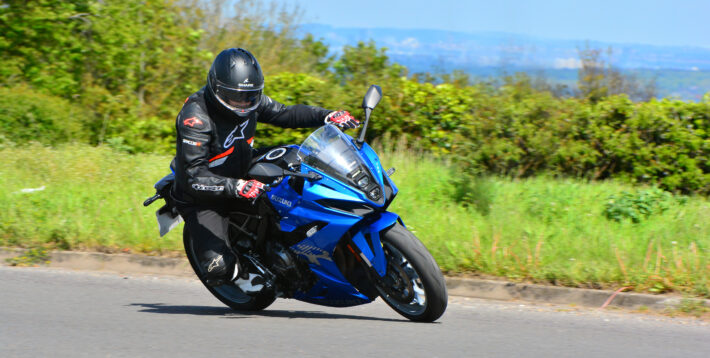
You’re definitely out in the weather, though the breeze is diverted up to your shoulders by the mid-level windscreen. Throwing it around some twisty back roads, the chassis is fun and manageable.
The weather has picked up a little, and I start to get into the sportier swing of things, braking harder into bends, and turning in a little harder. Suzuki has upgraded both the brakes and the forks compared with the GSX-8S naked model, and the front end feels as sharp as you’d want in a road-focused sports model.
The twin Nissin four-pot brakes have plenty of stopping power, and while the ABS is a non-cornering setup, it’s unobtrusive on the road.
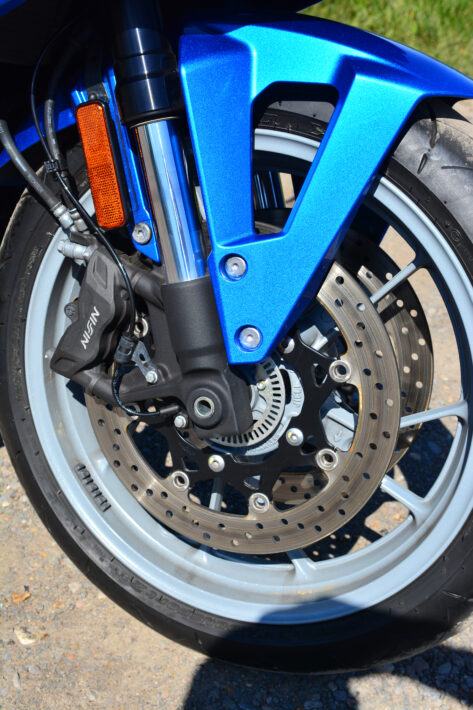
The motor is strong in the midrange, with a pleasant bark, and the quickshifter is great, both up and down. It pulls well out of a roundabout or slower bend, with clean throttle response and slick fuelling. You obviously need to work harder to keep speeds up than on the GSX-S1000 GX, which is actually a bit of a benefit on today’s roads of course…
Google Maps has taken me down a new dual carriageway this morning, and a headlight flash from the other direction warns me about a speed camera on an overpass round the corner. It’s no big deal – I’m going steady enough and not taking the mickey, but the need to dial in revs and gearchanges gives you a more involved ride, at a lower speed.

There’s definitely more fun in riding a bike closer to its limits, and that’s much easier on the road with 80bhp than 160bhp.
Before I know it, I’m back on the M25 and sampling the 8R’s high speed cruising manners. The midrange is spot-on for overtakes without changing down more than one gear, and it’s right at home in the typical 60-80mph motorway zone.
The large LCD TFT display is great, super-bright, and easy to read on the go. Once you work out the trip buttons, you can quickly scroll round the odometer, trip, range remaining and consumption figures. The motor sips fuel when you’re going easy – which is just as well considering the tiny 14 litre fuel tank. But when you turn the wick up a bit, the claimed 67mpg is a distant memory, and the tank range isn’t great.
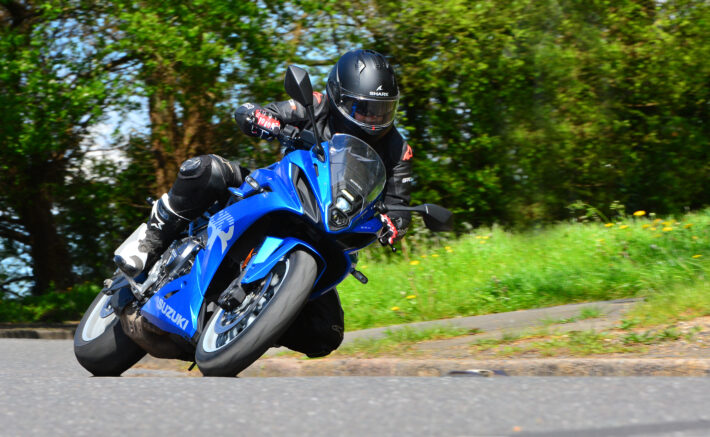
It’s one of my pet hates these days: the bike firms seem to take the ‘best case’ fuel consumption figures and size the tank to match. Adding an extra three or four litres to the capacity would make little difference to the bike in terms of style or performance, but the extra 50 miles would make a real difference in day to day usage, especially if you do many longer runs.
Also missing for long runs is cruise control, which is one of those things I never really thought I’d miss, but which I’ve now grown used to on modern bikes and really appreciate for stuff like 50mph average speed sections on motorways.
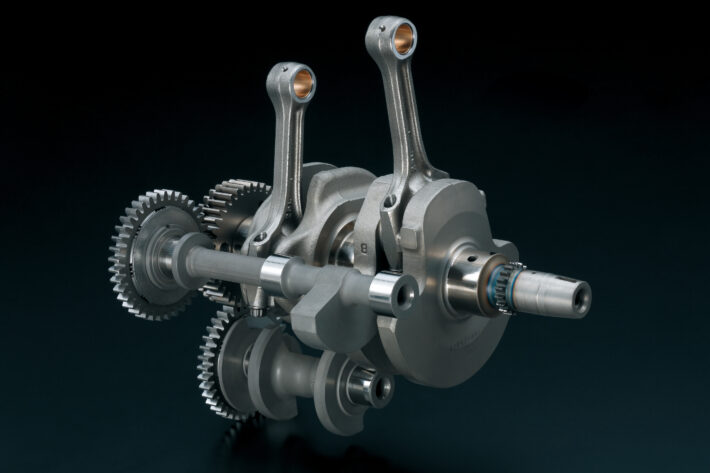
Off the M25 and onto one of the quieter sections of dual carriageway into London, where you can give a bike a cheeky handful to see how it pulls all the way through the revs.
This confirms what I thought earlier – the 8R is a bit short on ultimate top-end, with quite a flat power delivery as the revs top out. That’s no real surprise on a fairly budget twin-cylinder machine like this of course, but it’s a reminder of what we’ve lost with the decline of bikes like the GSX-R750.
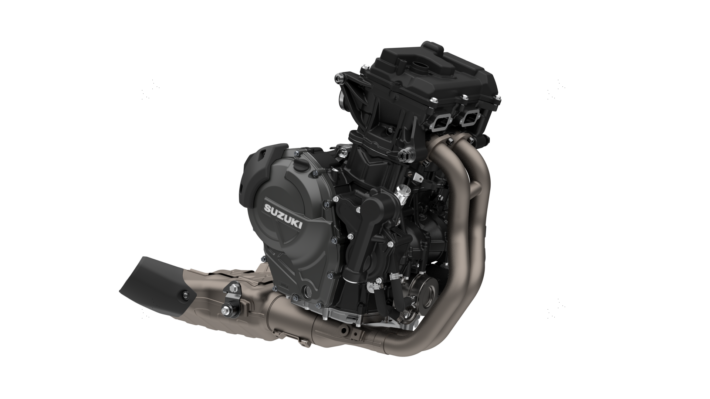
That was a brilliant powerplant, with good midrange grunt, yet the screaming top end of a supersports four. If anyone was thinking that the GSX-8R would be nearly as strong as the old seven-fiddy, they’re some way off sadly.
Over the next couple of weeks, the GSX-8R fits nicely into my life. It has limits on practicality: I couldn’t get a magnetic tank bag to sit nicely, there’s little in the way of pillion comfort, the windscreen is pretty low, and that 14 litre fuel tank was a pain: I was looking to stop not far past 110 miles. On the other hand, the dashboard is great, the riding position is comfy, mirrors work well and it’s really nimble around town.
Doing some cornering shots, the chassis felt composed enough, though I was a little short on confidence in the stock Dunlop Roadsport 2 tyres. I never had any ‘moments’, and while it was sunny and dry, the Tarmac was on the cool side that day.
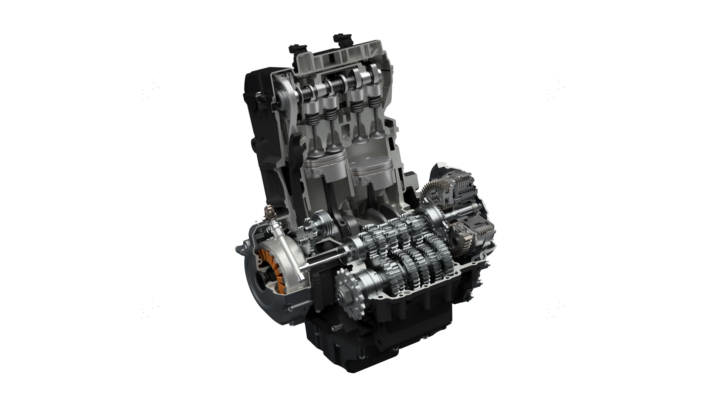
But in terms of really confidence-inspiring feedback, I wanted a bit more – it would be good to see if a grippier fitment made a difference.
As it is, the overall GSX-8R package is really solid – especially for the cash. It looks good, in a distinctive fashion, has almost all the tech you could reasonably expect for the money, and has a fun, satisfying engine.
If you’re very serious, you’ll already be looking at stickier rubber, sharper brake pads and steel hoses, an end can and ECU map – all of which would definitely add to the experience. None of that is essential though – the sportsbike class is very much back, and the new GSX-8R is a great member of it.
Photo Credit – John Goodman
GSX-8R Ratings
Engine
8/10
Chassis
8/10
Technology/equipment
7/10
Styling
7/10
Practicality
7/10
Overall
8/10
SPECS
Price: £8,899 (May 2024)
Engine: DOHC 8v, parallel twin, l/c, 776cc
Bore x stroke: 84x70mm
Compression ratio: 12.8:1
Carburation: EFI, ride-by-wire throttle bodies
Max power (claimed) 81hp@8,500rpm
Max torque (claimed) 78Nm@6,800rpm
Transmission: six speed gearbox, wet slipper clutch, chain drive
Frame: steel perimeter, bolt-on aluminium rear subframe
Front suspension: 43mm Showa SFF-BPF USD fork
Rear suspension: aluminium swingarm, Showa monoshock with preload adjuster
Brakes: twin 310mm discs, four-piston Nissin radial calipers (front), 240mm disc, single-piston caliper (rear), ABS.
Wheels/tyres: cast aluminium/Dunlop Roadsport 2, 120/70 17 front, 180/55 17 rear
Rake/trail: 25°/104mm
Wheelbase: 1,465mm
Kerb weight : 205kg
Fuel capacity: 14 litres
Equipment: LED lighting, power modes, up/down quickshifter, ABS and switchable traction control, colour LCD dash
TECH BOXES
Engine
776cc parallel twin with 270° crank firing order, and a patented dual balancer shaft system, with the balancer shafts arranged at 90° to each other to reduce primary vibration. Long-reach iridium spark plugs for improved combustion, slipper/assist clutch. Pistons are 84mm forged items, running in plated aluminium bores.
Frame
Steel perimeter design, with a bolt-on aluminium rear subframe, and a fabricated aluminium swingarm.
Suspension
Showa separate function front forks have damping cartridge in just one leg, allowing a bigger damping piston for better performance, while saving weight. Showa rear monoshock has a stepped preload adjuster, which is the only suspension adjustment on the bike.
Electronics
Standard Suzuki package, with three-level (plus off) traction control and ABS, without an IMU inertial measurement unit. Up/down quickshifter, three-way rider power modes, and the large 5” TFT colour LCD dash rounds off the electronic equipment listing.